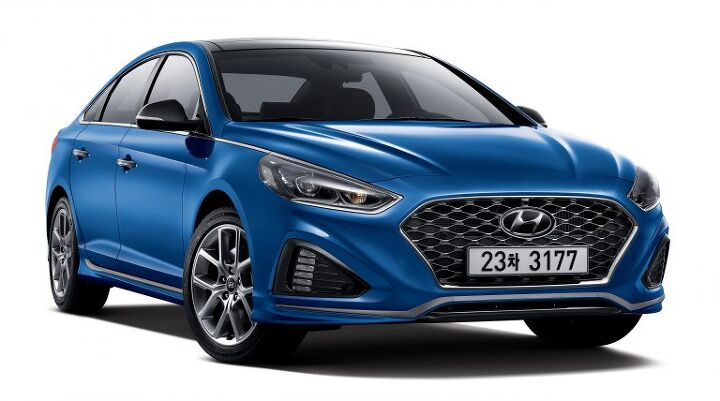2018 Hyundai Sonata Revealed in Seoul, Hopes to Stimulate Midsize Sales

If public backlash against the sixth-generation Sonata, mainly in its home country, caused Hyundai to pour cold water all over the midsize sedan’s edgy design, consider the 2018 Sonata a reaction to its toned-down predecessor.
The refreshed 2018 Sonata unveiled in Seoul, South Korea, today aims to shelter the popular midsize from accusations of “safe” or “boring” styling. While the sedan’s flanks are easily recognized, the previous model’s this-won’t-offend-anyone front fascia has given way to a wholly new design.
Unlike the 2014-2017 model, the new Sonata’s grille follows a trend set by its smaller stablemates, opening wide and filling the center of its face. While the existing Sonata Hybrid already ventured in this direction, the 2018 update brings a cleaner, more cohesive look. Sport models see a mesh-filled grill, with others making do with familiar chrome bars.
Completing the front-end makeover are vertically stacked LED running lights and a sculpted hood. Out back, the Sonata’s taillights continue the diagonal motif established by the smaller Elantra.
Midsize cars are having an especially hard time as of late, and the automaker can’t afford to rest on its laurels while its rivals fight over remaining buyers. Hyundai saw Sonata sales peak in 2012.
Hyundai hasn’t taken this opportunity to boost its competitiveness in the infotainment screen size race. (Not that it lagged the competition by an appreciable degree.) For 2018, the Sonata maintains a standard 7-inch touchscreen, while those with extra bills in their pocket can plunk an 8-inch unit into the redesigned center stack.
Rear seat users gain a USB charging port, while front seat occupants can now enjoy the plug-free bliss of wireless charging. Apple CarPlay and Android Auto connectivity rounds out the convenience upgrades. On the safety front, buyers can cocoon themselves in more technology than before, with Lane Keep Assist now available.
While engine choices carry over from last year, an eight-speed automatic now comes standard in Sport 2.0T models. That model also brings a helping of black trim and dark chrome moldings, in addition to the aforementioned grille mesh. Other non-hybrid models retain the tried-and-true six-speed automatic.
Because the Sonata unveiled in Seoul is bound for the Korean market, we’ll have to wait until next month’s New York Auto Show to hear any North American specifics.
[Images: Hyundai Motor]

More by Steph Willems
Latest Car Reviews
Read moreLatest Product Reviews
Read moreRecent Comments
- Kjhkjlhkjhkljh kljhjkhjklhkjh A prelude is a bad idea. There is already Acura with all the weird sport trims. This will not make back it's R&D money.
- Analoggrotto I don't see a red car here, how blazing stupid are you people?
- Redapple2 Love the wheels
- Redapple2 Good luck to them. They used to make great cars. 510. 240Z, Sentra SE-R. Maxima. Frontier.
- Joe65688619 Under Ghosn they went through the same short-term bottom-line thinking that GM did in the 80s/90s, and they have not recovered say, to their heyday in the 50s and 60s in terms of market share and innovation. Poor design decisions (a CVT in their front-wheel drive "4-Door Sports Car", model overlap in a poorly performing segment (they never needed the Altima AND the Maxima...what they needed was one vehicle with different drivetrain, including hybrid, to compete with the Accord/Camry, and decontenting their vehicles: My 2012 QX56 (I know, not a Nissan, but the same holds for the Armada) had power rear windows in the cargo area that could vent, a glass hatch on the back door that could be opened separate from the whole liftgate (in such a tall vehicle, kinda essential if you have it in a garage and want to load the trunk without having to open the garage door to make room for the lift gate), a nice driver's side folding armrest, and a few other quality-of-life details absent from my 2018 QX80. In a competitive market this attention to detai is can be the differentiator that sell cars. Now they are caught in the middle of the market, competing more with Hyundai and Kia and selling discounted vehicles near the same price points, but losing money on them. They invested also invested a lot in niche platforms. The Leaf was one of the first full EVs, but never really evolved. They misjudged the market - luxury EVs are selling, small budget models not so much. Variable compression engines offering little in terms of real-world power or tech, let a lot of complexity that is leading to higher failure rates. Aside from the Z and GT-R (low volume models), not much forced induction (whether your a fan or not, look at what Honda did with the CR-V and Acura RDX - same chassis, slap a turbo on it, make it nicer inside, and now you can sell it as a semi-premium brand with higher markup). That said, I do believe they retain the technical and engineering capability to do far better. About time management realized they need to make smarter investments and understand their markets better.



































Comments
Join the conversation
Seems like lots of people are raving about it, but I don't like it. The front just doesn't fit the car. I do like the tail lights, but seriously isn't "S O N A T A" late 90s, early 2000s?
I don't get it. Hyundai gave us a Sonata with terrific swoopy styling and the ability to hold its own with anything in the class...only to turn around a couple years later and nix the edgy styling, inside and out, to create the current car, which looks like one of those "generic" cars photoshopped together for auto-insurance ads. And now they've done one worse and grafted onto that a gaping maw that approaches Toyota levels of styling hideousness. WHAT ARE YOU DOING, HYUNDAI? Honestly, just bring back the swoopy one, it will look newer than the current model or this "new" model.